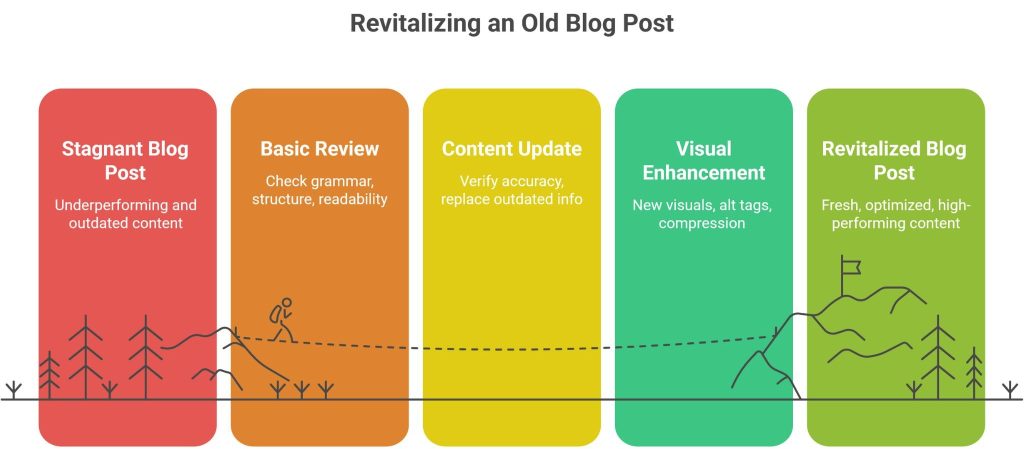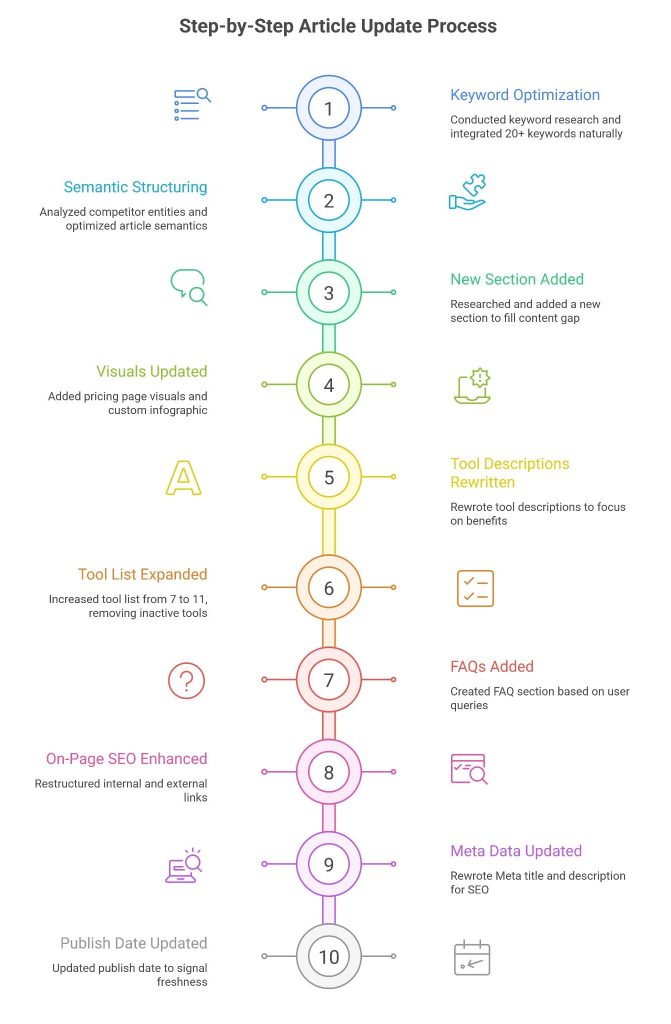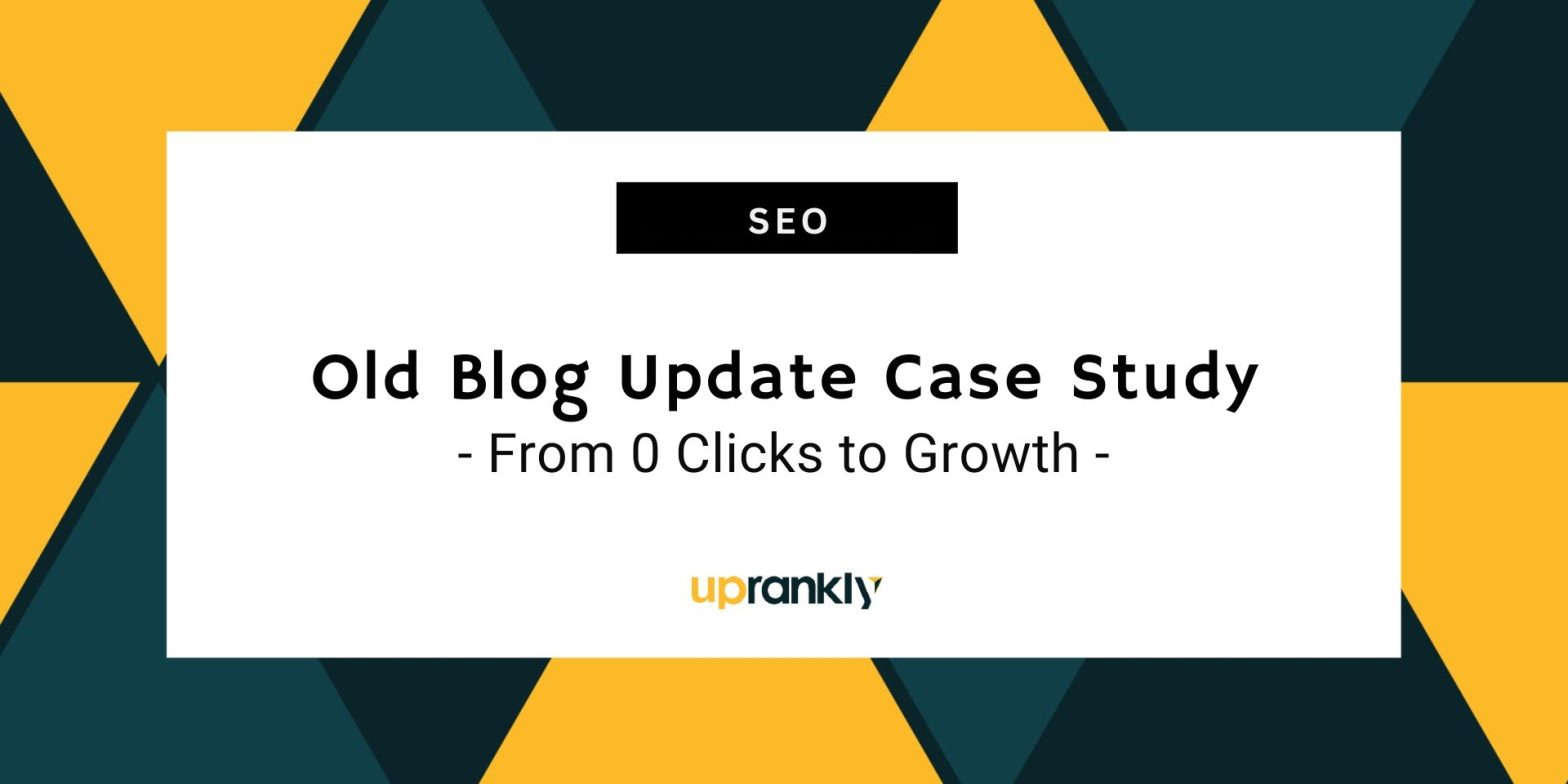Have you ever optimized a blog post perfectly, only to see no growth?
That was our situation with the blogger outreach tool article. Despite following every SEO best practice, it was averaging only 50 impressions per day and 0 clicks for nine straight months.
Even with optimized keywords, visuals, and Meta tags, the results remained flat.
After 9 months of no growth, we decided to audit and update the article. We aimed to increase impressions, achieve consistent clicks, and improve the post’s ranking for new, high-intent keywords that would bring it back into visibility.
Within a week of the update, the article began to show results. Impressions grew by 100+ per day, and the average position improved by 35 points.
Moreover, the post began ranking #1 for one keyword with an SV of 90 (we used SEMrush). These early wins proved that a structured update can turn old content into a new growth driver.
This Uprankly‘s old blog update case study walks through every stage of how we revamped an under-performing blog post and turned it into a ranking asset again. Continue reading.
The Challenge: What Wasn’t Working Anymore
We published our blogger outreach tool article in 2024. From the start, it averaged around 50 impressions and stayed there for months.
The goal behind this blog was simple: we planned to build our own link building automation tool, and this article was intended to create early visibility around that topic. So naturally, we paid extra attention to it.
But even with consistent monitoring, the performance didn’t improve.
Everything seemed right on paper,
- Keywords were properly placed.
- Secondary keywords were used naturally.
- The content had enough depth.
- Meta title and description were optimized.
- Each listed tool was well-researched.
- Competitor articles were analyzed.
- Visuals were clear and relevant.
Still, the blog didn’t gain traction.
That’s what made this case so challenging: when everything looks perfect, but the numbers say otherwise.
After nine months, we finally decided to conduct in-depth research and determine exactly what we were missing.
We also learned something important from these results: following all SEO best practices is not enough on its own. A post must be semantically structured and include accurate entities so that search engines can fully understand the topic.
This is exactly what we plan to do for the improvements. In the following sections, we will discuss these points in more detail.
The Goal: What We Wanted to Achieve with Blog Revamp
Our main goal was simple. We wanted to increase impressions, clicks, and keyword rankings for the blogger outreach tool article. The content had strong potential, but it was not reaching enough people.
We wanted to understand why it was stuck at 50 impressions and what steps could help it perform better in search results. Our goal was to increase the article’s ranking on Google for both primary and secondary keywords.
Additionally, we aimed to increase the number of users who clicked and read the blog. That meant improving the way our title, Meta description, and overall message appeared in search results.
The goal was not just traffic growth but also stronger visibility and proof that updating old content can unlock real SEO results.
The Audit: How We Analyzed the Old Post

Before making any updates, we decided to run a full audit of our Blogger Outreach Tool article. The goal was to find exactly what held it back, even when everything seemed right.
Checking the Basics
We started with a full review of the blog’s quality and structure. We read the article line by line to find grammar issues, long sentences, and unclear flow. Although the content was solid, it would benefit from shorter paragraphs and smoother readability.
Reviewing Content Relevance
Next, we checked if the information was still accurate. Some tools we mentioned had changed features or pricing, while a few were no longer active. We marked those sections for replacement and planned to add updated data.
Improving Visuals and Formatting
Some visuals looked outdated, and none of the images had proper alt tags. We decided to create new visuals, compress image sizes, and add alt text to every image for better SEO and accessibility.
Strengthening Internal and External Links
The post had very few internal links, which limited its SEO strength. We listed newer blogs to interlink and added relevant external sources for credibility. This step aimed to build stronger topical connections across the site.
Analyzing Keyword Data
Using Google Search Console, we looked for keywords that had impressions but no clicks. We found several and naturally incorporated them into headings and content. This helped us target search intent more effectively without keyword stuffing.
Rewriting Meta Tags and CTR Hooks
The Meta title and description looked fine, but they lacked a strong reason to click. We rewrote them with a clearer benefit and emotional pull to raise CTR.
Setting a Republishing Plan
After all updates, we planned to republish the post with a new date. This simple step helps Google view the article as fresh and active again, often resulting in a ranking boost.
The Strategy: Our Step-by-Step Update Process

After identifying what was missing, we created a detailed plan to revitalize the article. Each step was designed to improve visibility, engagement, and keyword performance.
Keyword Optimization
We began with keyword research using Google Search Console. It helped us find new search terms where the article was already getting impressions but no clicks.
Additionally, we analyzed our competitors and extracted keyword ideas directly from their top-ranking pages.
In total, we optimized the article with 20+ keywords placed naturally across H2s, H3s, and body sections. The goal was to create a natural flow that matches search intent without overstuffing.
Semantically Structured and Optimized with Entities
We analyzed the top-ranking competitor articles and listed the entities they used. We then naturally added those entities across our content. Instead of repeating the main keyword, we used related terms such as outreach automation and campaign tracking.
Each heading was arranged logically to build context. This made the article semantically stronger and helped Google understand topic relevance, improving how the post ranked for multiple connected keywords.
Adding a New Section for Content Depth
During our competitor analysis, we noticed that none of the top articles addressed a specific angle that was important to readers.
To fill that gap, we researched communities and forums to confirm that the missing topic truly mattered.
Once validated, we added this new section to increase content depth and provide fresh value that competitors overlooked.
Updating Visuals and Design
Earlier, the post only used homepage screenshots of the listed tools. This time, we added pricing page visuals, as pricing is a major factor in readers’ decisions to buy a tool.
We also designed and inserted a custom infographic to visually summarize the process, making the article more engaging and easier to scan.
Rewriting Tool Descriptions
Each tool description was rewritten to focus on benefits rather than features.
Instead of listing what a tool does, we explained how those features help users achieve their goals. This small shift made the content sound more persuasive and user-focused.
Expanding and Updating the Tool List
We increased the number of tools from 7 to 11. Two of the older tools were removed because they were no longer active.
Each new tool was properly reviewed to ensure its quality and relevance. We carefully compared their features before including them to keep the list accurate and trustworthy.
Adding New FAQs
We added a FAQ section based on insights from People Also Ask results, competitor blogs, and questions appearing in Google Search Console. This helped target long-tail queries and improve the post’s chance of capturing featured snippets.
On-Page SEO Enhancements
We restructured internal and external links. Internal links now point to newer and more relevant articles, helping Google understand our content hierarchy. External links were checked to remove broken URLs and replaced with current, high-quality references.
Improving Meta Title and Meta Description
We rewrote the Meta title and description in accordance with SEO best practices. The title now includes the primary keyword at the beginning and employs clear, action-driven language. The Meta description highlights the article’s benefit to readers, written in a way that encourages clicks without sounding promotional.
Updating the Publish Date
Finally, we updated the publish date to signal freshness to both readers and search engines. Republishing updated content helps Google Recrawl the page faster and treat it as newly optimized content. It also boosts user trust because people prefer reading posts that appear recent and relevant.
The Results: Before vs. After Performance

After finishing the update, we gave the article a week to settle before checking performance in Google Search Console. The difference was easy to notice. The data confirmed that our efforts worked. The updated version outperformed the old one in every area.
The table shows the SEO performance improvement after the content update. It highlights growth in clicks, impressions, rankings, and engagement.
| Metric | Before Update | After Update | Growth / Change |
|---|---|---|---|
| Total Clicks | 0 | 3 | Increased |
| Total Impressions | 279 | 2,110 | +656% |
| Average CTR | 0% | 0.1% | Improved |
| Average Position | 37.5 | 25.3 | +12.2 positions |
| Top Keyword | — | Hands Free Blog Outreach (Rank #1) | New Keyword Ranked |
| New Keywords Picked Up | — | 40+ | Expanded Keyword Reach |
| Keywords on Page 1 | — | 10 | Higher Visibility |
| User Engagement | Low | Improved | Longer On-Page Time |
| Visual & Content Updates | Minimal | Infographics, New Images, FAQs | Enhanced Readability |
The Numbers Tell the Story
Before the update, the post had almost no traction. It was averaging 279 impressions and zero clicks. After just one week, impressions increased to over 2,100, which is a growth of more than 650 percent. The blog also started receiving three clicks, which might look small, but marks the beginning of steady engagement.
Our average position improved from 37.5 to 25.3, indicating that Google began to value the refreshed content. The click-through rate (CTR) also rose slightly from 0 to 0.1 percent, indicating that the new title and Meta description were effective in increasing engagement.
Ranking Improvements and New Keywords
The most notable improvement was in keyword performance. Before the update, the article did not rank for any notable keywords. After the optimization, it began ranking #1 for “Hands Free Blog Outreach.”
This keyword had a good search volume and clear intent, making it a perfect match for our content. Ranking first for this term gave the post instant visibility and positioned it as an authority in that specific niche.
Beyond that, the article garnered over 40 new keywords, indicating that Google now comprehended the topic in greater depth. Around 10 of those new keywords appeared on the first page of search results. This confirmed that the improvements in keyword placement, structure, and FAQ inclusion made the post more semantically rich and contextually relevant.
Why the Update Worked
Several factors contributed to this result. Adding new sections and FAQs increased the overall depth and effectively covered user questions. Internal linking helped connect the post with related articles, signaling topical authority to Google.
The visual improvements, including updated tool screenshots and a new infographic, made readers stay longer on the page. Better engagement metrics helped the post climb faster in the rankings.
Finally, the rewritten Meta title and description improved visibility and attracted more clicks, while updating the publish date helped Google treat it as fresh content.
4. Long-Term Impact
Within a week, we saw early signs of growth, and over the next few months, the performance continued to rise. The increase in impressions and keyword reach showed that the update didn’t just fix the post; it gave it a new life.
The case proved that even a single old blog, when updated strategically, can yield strong SEO results and uncover new keyword opportunities.
The Insights: What We Learned from the Update
Refreshing the Blogger Outreach Tool article gave us more than higher rankings. It showed us what truly works when you update old content with purpose. Here are the key lessons we learned from this project:
- Semantic SEO improves content clarity. Structuring content around related entities and context is the key, not just keywords. Such an approach helped Google better understand our topic and improve overall ranking visibility.
- Small changes can create big results. Even minor updates, such as rewording a title or adding a missing keyword, can make a noticeable difference in impressions and ranking.
- Freshness matters. Updating the publish date and replacing old visuals helped Google recognize the content as new and relevant again.
- Depth beats length. Adding one well-researched section that competitors missed gave us a strong edge and helped increase topical authority.
- User intent must guide every keyword. The success of “hands-free blog outreach” showed that relevance and intent matter more than search volume.
- Visuals improve engagement. Screenshots, infographics, and updated images made users stay longer, reducing bounce rate and improving engagement signals.
- Internal linking builds strength. Connecting the blog with newer articles helped Google understand the content structure and boosted visibility site-wide.
- Meta optimization influences CTR. A clear, benefit-driven title and description can increase click-through rates, even without drastic ranking jumps.
- Continuous monitoring is key. Checking Search Console data after every update helps identify new keyword opportunities and maintain consistent growth.
The Takeaways: Actionable Tips for Other Marketers
Updating old blog posts is not just a maintenance task; it’s also an opportunity to enhance the content and improve its relevance. It is a growth strategy. This case demonstrated that small, structured updates can yield a significant SEO boost. Here are a few simple tips any marketer can apply to get similar results.
- Tip #01: Start with Google Search Console
Check which keywords are getting impressions but no clicks. Add those keywords in natural places, such as subheadings or short sentences. This helps improve relevance without changing the main topic.
- Tip #02: Go Beyond Keywords, Focus on Semantic and Entity Terms
Search engines understand topics through related terms, not just target keywords. Use connected phrases, tool names, and entity-based terms that define your topic. This makes your content stronger and easier for Google to index accurately.
- Tip #03: Add One New, Unique Section
Find a missing angle that competitors have ignored. Add a new section with practical insights or data that readers will find useful. It can instantly improve your topical depth.
- Tip #04: Keep Your Visuals Fresh
Use updated screenshots, infographics, and product images. Clear visuals make your blog look modern and help users stay on the page longer.
- Tip #05: Recheck Links and Add New Ones
Add internal links to newer articles and fix or remove outdated external links. It helps Google understand how your content connects across the site.
- Tip #06: Rewrite Meta Tags with a Benefit in Mind
Focus on why someone should click your article. Keep your Meta title short, add the main keyword early, and make the description promise a clear takeaway.
- Tip #07: Republish with a New Date
Always update the publish date after making real changes. It shows freshness to readers and helps search engines recrawl your page more quickly.
- Tip #08: Track and Improve Again
Check the new data after a week or two. Note what worked and what did not. Use that feedback to refine your next update.
Wrap Up
This project turned out to be one of our most rewarding experiences. It took time, patience, and continuous refinement before we began to see growth.
Once the updated post gained traction, the results compounded, leading to rankings and broader keyword visibility. It reminded us that real SEO progress doesn’t happen overnight.
Consistent updates, smart optimization, and long-term commitment are what truly transform an old blog update into a lasting traffic asset.
If you need suggestion about old blog post update or link building services, email us.
